Tie Masterclass 2023: Selecting The Right Collar & Knot For Your Tie
Men’s dress shirt collars and ties are the lingua franca of the modern world. In the right hands, you can shape your shirt and tie to represent sophistication, duty, responsibility, or professionalism. But it takes time to understand the rules and develop your own personal style.
Below is a concise masterclass in collars & tie knots including:
- The different collar styles and when to wear them
- The 4 main tie knots and how to tie them
- Tie knot and collar matching
You can find our full handmade tie collection on the following link: Handmade Tie Collection.
How to Match a Tie Knot to Your Collar
In our video below, fashion consultant Chris Modoo outlines how to match your tie knot to your collar.
The Best Tie Knot?
We are often asked, what is the best tie knot? The answer to this is not that there is one best knot, only that there is a best knot depending on the context. The most important element is proportion. You want to aim for a balanced look between your the size of your collar, the type of tie fabric. For example if you have a thick tie fabric like a Shantung with a small shirt collar, then a large Windsor knot will look totally out of proportion.
The occasion also plays a roll, for more formal occasions or perhaps a business environment then a larger knot will be appropriate, perhaps with a cutaway collar. For a more casual setting with a chambray shirt then a four in hand would be a better choice. In terms of thinking about your tie knot in relation to the occasion from least formal to most formal of the four most popular knots we would rank them below:
- Simple/Oriental Knot
- Four in Hand Knot
- Half-Windsor Knot
- Windsor Knot
Collar Styles
“Style is what makes you different to others. Fashion is what makes you the same.” - Glenn O’Brien.
Choosing a shirt collar that complements both your environment and your sartorial charisma is the first step you’ll take in mastering your personal style. Different shirt collars portray different men altogether, meaning you can turn yourself into a stylish rogue or a polished gentleman simply by changing dress shirts. Remember: the littlest details often make the largest impressions.
Once you learn the rules backwards and forwards, you’ll be able to utilize and bend them like only a truly stylish man can.
Forward Point Collar

This is the original collar style. No frills, no nonsense, and no additional design quirks need apply. Its traditional looks ensure you’ll look stylish, though it’s safer than its more contemporary cousins, like the spread collar. When you wear this timeless style, you’re going to feel more Prince Charles than Iggy Pop. Its collar points are long enough to bachata in the breeze, so best not to go boating at high speeds in one of these.
Button-Down Collar
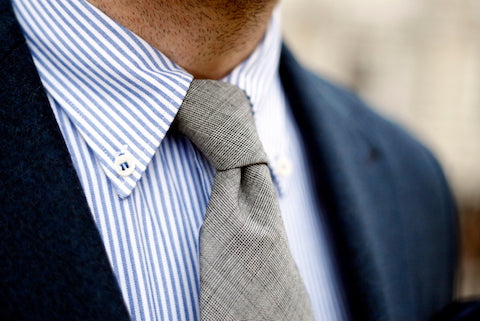
Thanks to its origins as a way for polo players to keep their collars from flapping as they raced about the playing field, the iconic button-down collar is a mainstay of prep style. You’ll see it on every corner in every urban center from Naples to Oxford, and for good reason: the button-down collar balances casual aesthetics and a classy prep soul.
Texture and heft pair well with button-down collars. Think sepia photo filters, tweed jackets, and workboots with a healthy patina.
Spread Collar

Where your lapels meet the fine fabric of your shirt, that’s where you’ll find the sculpted contour of the spread collar. This collar style resists wrinkling, meaning its practicality matches its modern style.
Spread collars serve that middle ground between the point collar’s traditional looks and the cutaway collar’s futurism. Whether you’re attending a first interview or making an appearance at a cocktail-casual fundraiser, the spread collar will separate you from the rest of the pack.
Our friends at RMRS have a short piece about how the spread collar can flatter certain face shapes.
Cutaway Collar

Adjectives like “clean” and “contemporary” best define the energy of the cutaway collar. Its tidy silhouette runs along your collarbone, which creates a handsome visual contrast with the vertical lines of your lapels and your tie.
The cutaway’s original moniker, the Windsor collar, alludes to the knot that suits it best -- best to remember to wear ties that feature bold designs. The negative space from a lack of collar material means curious eyes will be instinctively drawn to that handsome piece of fabric you knot around your neck.
Winged Collar

Heavy on the starch and heavier on the charisma, the winged collar will signal your know-how at formal black-tie events. What was once a standout style at the beginning of the 20th century -- the golden age of formal wear -- is now reserved for formal situations where you’ll want to look sleek and sophisticated.
Its collar points fold outwards, flattering your face no matter its shape while exposing space for your bow-tie. Remember to tuck those wings behind the bow!
Club Collar
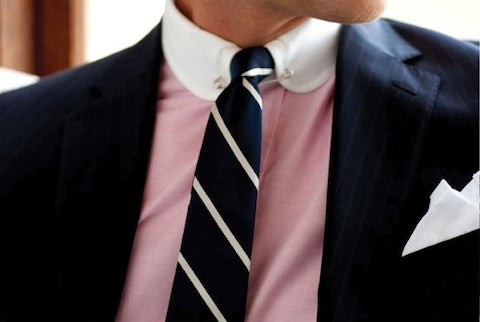
The signature Eton look. Take your pointed collars and round them -- voila, you’ve got a club collar. The convex curvature of this collar’s ends picked up steam in the early 20th century, buoyed by how well it paired with collar bar. In fact, it’s a great option for wearing a collar bar, if you want to add some old-school polish to your aesthetic. What was once a marker of high-society status is now an aesthetically charming collar choice that’s sure to turn heads wherever you wear it.
Detachable Collar
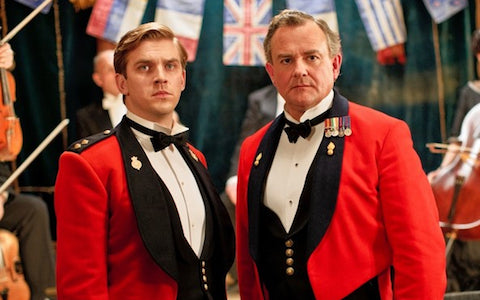
Perhaps we should call these the gem of a bygone era. The detachable collar is a relic of the Victorian past, something worn by upper-class men who needed to enlist valets or butlers to help them dress. The collar itself was starchy and stiff, meant to stand up and stand out.
The rigidity of the detachable collar lends well to proper formal events. Don’t wear one of these to a yacht party...
Collar Bars

A final note. If you’re wondering what the best tie knot for wearing a collar bar is, that would be knots like the four-in-hand or half-Windsor. They are full enough so that the bar is not too exposed, but not so large as to obfuscate the bar altogether. Tom Ford and Tom Hiddleston represent the far ends of that spectrum, from thick to thin and represent the extreme of each size. Each man’s knot width allows the bar to stand out without being too distracting.
THREE CLASSIC TIE KNOTS FOR EVERY OCCASION
Understanding the different types of tie knots is just as important as knowing how to style and wear them.
In our latest video details series, we explore three knots that are perfect for any occasion, from work attire to being wedding season ready. In addition, we have a technique tying video for each knot which not only demonstrates how to tie in a nice compact fashion, but also how to achieve a perfect dimple every time
Tie Knots
Curating a selection of fine ties is easy. Styling them is not. “What is the most stylish tie knot?” the man wonders to himself, statuesque before a mirror, readying for an evening among perhaps friends, or family, or romantic interests. Worry not, old sport -- they’re all stylish, given you know how to tie them correctly.
Learning how to tie a tie is as simple as tying your shoelaces, and just as important. And you’ll especially begin to have fun with it when you learn which different tie knots elevate your look.
A note on texture: thick ties generally benefit from smaller knots. If you take 50 oz tie and have a full Windsor you will end up with a knot so large it will totally overpower your look. You don’t want to go wrapping something heftier round and round until it looks like you’ve got a wrinkled fabric apple resting under your collar.
Below is an example using one of our wool/cashmere blend ties with an 8cm blade which are a heavier, more luxurious fabric. You can see that knot used below is a Four-in-Hand which keeps the knot nicely in proportion to the collar and lapels. Therefore there is no such thing as the best tie knot. It's all about proportion, for both the weight of your tie and the size of your collar.
Simple Knot or Oriental Knot
Basics first, chaps. You’ve got to crawl before you can walk. The simple knot, also known as the Oriental Knot is (you guessed it) exceedingly simple to tie. It’s also the knot you’ll want to use if you’re rocking a skinny tie. The tie knot consists of only a single loop around the skinny end, so it’s got very little bulk to it. Simple knots work best with ties that are cut thick and made with fabrics like wool -- the more heft, the better.
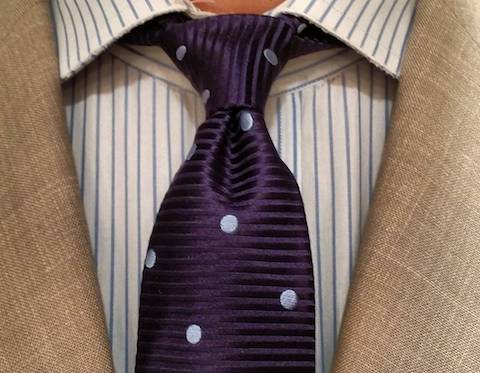
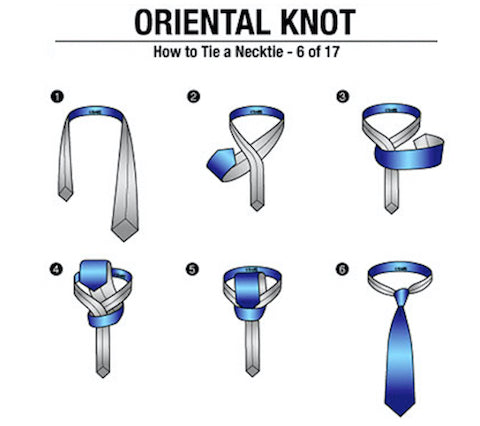 Image Source: Realmenrealstyle.com
Image Source: Realmenrealstyle.com
Four-in-Hand
The Four-in-Hand is like that unconstructed navy cotton blazer you can’t stop wearing out -- it’s reliable no matter the situation. As the most versatile tie knot, the Four-in-Hand works because it’s slender, not skinny, and exudes a charm of equal measures sophisticated and carefree.
What separates the Four-in-Hand from the simple knot is that the tying process includes an extra “loop” around the skinny end, so it’s a touch bulkier, as well as slightly more elongated. The Four-in-Hand is best for casual to semi-formal events and would be the choice of knots if you're wearing a most casual shirt such as an Oxford button down or a denim shirt.
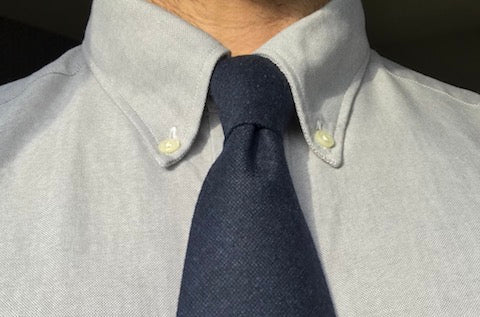
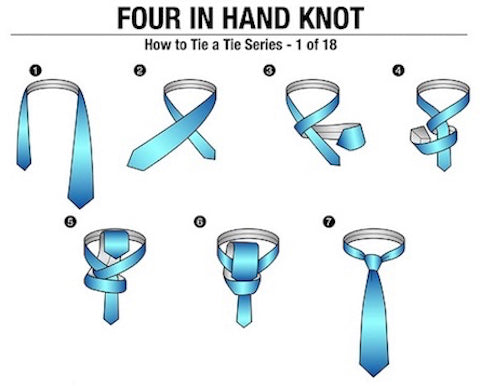
Image Source: Realmenrealstyle.com
Half Windsor
The half-Windsor knot is the little brother of the Windsor, an albatross of a tie knot streamlined for the modern minimalist. It’s a jack-of-all-trades, able to be dressed down or fancied up, and works with a variety of collar shapes and sizes. Use with light to medium-thick tie fabrics.
Simpler to tie than the full Windsor and being a slightly smaller knot the half Windsor is the perfect knot for everyday business wear. The half Windsor also has the classic symmetrical shape of the Windsor knot so always looks smart, particularly when you add the final touch of the dimple.

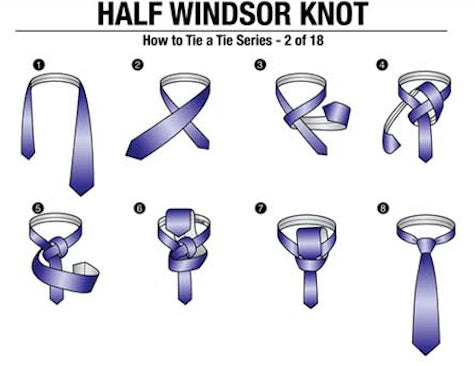
Image Source: Realmenrealstyle.com
Full Windsor
The Full Windsor knot was first invented as a way to emulate the Duke of Windsor's uncharacteristically large tie knots. It produces a wide, symmetrical triangle with a powerful charisma tailor-made for formal events.
This is the most formal of the standard tie knots and the key is to ensure you get your proportions correct. A full Windsor works best with a spread or cutaway collar so that you get the full effect of the knot, while your jacket lapels also need to reflect this. Definitely no skinny ties or skinny lapels with this knot.

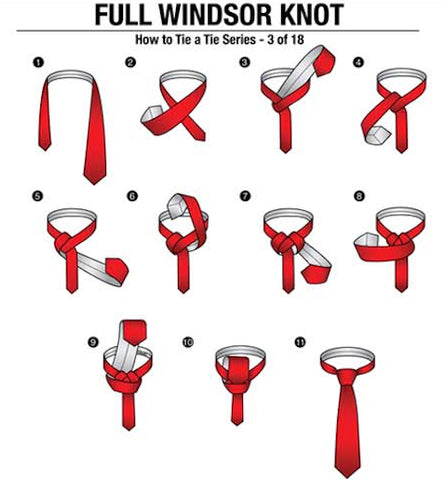
Image Source: Realmenrealstyle.com
Bow-tie
We would be remiss not to briefly mention the bow-tie. The descendant of the knotted cravat, and a staple of the active man who can’t have his tie flapping in the wind as he dashes from meeting to meeting.
If you really want to transmit that quirky, academic vibe, pair the bow-tie with tastefully pressed trousers and a crisp jacket. The best thing about bow ties are they are incredibly versatile and work with very casual shirts through to formal wing tips. Traditionally, black bow-ties are saved for dinner jackets and tuxedos, but if you’re in a casual setting, go wild with the patterns.
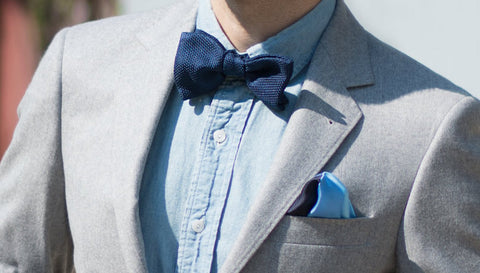
Tie Bars
Think of the tie bar like a finishing flourish for the fancy gentleman. It’s a suave and polished touch that adds visual interest to your simpler palettes. Plus, its functional use will keep your put-together charm a constant, as the bar will keep both ends of your tie fastened to your shirt.
Here are the rules. Not too high, and not too low. Use the bar to fasten both ends of your tie to the placket of your shirt. Generally, men slot their tie bars between the third and fourth buttons of the shirt.
Your tie bar should be somewhere around 3/4's of the width of your tie. Any shorter and it just looks like an odd clip, however, if your tie bar is the full width of your tie it effectively cuts your tie in half and ruining that finely polished or casual-cool look you've put together.
The only other point is to ensure that the tie bar is more or less horizontal. Any acute angles will definitely remove some of your satorial lustre.

Tie Dimples
The tie dimple functions much like cheek dimples do -- it’s a small wrinkle with a large dose of charm. To create a tie dimple, all you have to do is pinch the tie as you are sliding it through its final pass under your knot of choice.
A simple way to create the dimple (and a little bit of a cheat...) is to put your index finger in the middle of the tie under the knot with your thumb and forefinger either side as you pull the tie through to tighten the knot. With a little adjustment, you will have a nice tight knot with an aforementioned charming dimple that should stay in place all day.
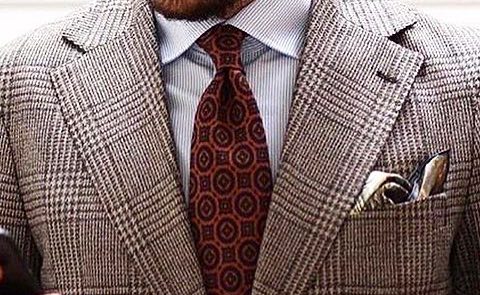
In our YouTube short below, Fashion Consultant Chris Modoo outlines why you should have a dimple with your tie knot.
Putting It All Together
So now you’ve got your shirts and your ties. You’ve built a hell of a wardrobe, and it’s time to show it off. First thing’s first. Aesthetic harmony (or tasteful disharmony) between your tie, collar, and suit should be at the front of your mind.
A general rule of thumb: the larger the knot, the more space you’ll want between the wings of your collar. The size of the knot should be sized up against the thickness, angles, and proportion of your shirt collar.
Spread collars, for example, do well paired with thick knots, because there’s more space beneath the collar to show off your knot with. The elongated forward point collar is complemented by the elongated, thin knot. It’s not a fat, full Windsor. It’s a slim four-in-hand. In fact, the four-in-hand, and its brother, the half-Windsor, are the jack-of-all trades knots you’ll want to master. They’re both simple to tie and hit that sweet spot between thick and thin, so you can match them to a variety of collars -- from club collars to the forward point.
TIPPED VS UPTIPPED TIES
Selecting the right collar is only one element of perfecting the art of tie wearing. Ties may look simple to make, but they can be constructed in many different ways, and each has its own unique number of folds. Tipping within a tie usually refers to the lining on the underside of the tie blade, which can be either tipped or untipped.
The classic construction and modern look would be a tie that is tipped. Typically, ties are self-tipped, where the tip is made from the same material and pattern as the shell fabric.
Self-tipped ties require extra fabric and detail within the construction, which is usually a sign of higher quality production value. At Rampley & Co, all our handmade tie collections come self-tipped as standard to keep a consistent design to the product, offering you the highest quality.
Pairing Your Tie and Pocket Square
Now you have your collar and tie in perfect harmony, the next option is to add a pocket square. Below we've outlined how to pair your tie and pocket square.
So that’s it. The thicker or wider the knot, the more space you’ll want between your collar points. From there, experiment with proportion and collar length. And be playful!
Our Top Five Best Selling Handmade Ties
Our handmade tie collection encompasses many styles and materials utilising the finest fabrics in the world. Once the fabrics are sourced from our partner mills in England and Italy, our ties are then handmade in England by skilled craftsmen to the highest possible standards. In our video below, Leah reveals our best-selling ties from the last year.
5 - NAVY, EMERALD & YELLOW STRIPED SHANTUNG SILK TIE
Starting off our countdown, at number 5 is our Navy, Emerald & Yellow Striped Shantung Silk Tie. This particular tie is a beautiful addition to our handmade tie collection as it featured Italian woven Shantung silk. The weaving of thicker yarns into the silk results in a tie that is truly unique, while the texture also lends itself perfectly to a more casual look.
The silk used here is woven in northern Italy using both traditional and modern machines and methods, by craftsmen working to the highest standards. Established as a centre of silk production since the 16th century, northern Italy is synonymous with the highest quality silks which we are proud to use for our Shantung ties.
4 - STEEL GREY AND BLUE GLEN CHECK MERINO WOOL TIE
Next on our list of best-selling ties, is the classic Steel Grey and Blue Glen Check in 100% Merino Wool Tie , which is entirely handmade in England using fabric from the world-renowned Fox Brothers & Co. A classic glen check tie always works well with a plain navy or lightly patterned jacket.
The cloth for the tie is woven in Somerset, to the highest possible standards, using the finest raw materials. We’ve chosen Fox Brothers cloth for a number of ties in our collection as it is a company known the world over for their quality fabrics, having been producing cloth for over 250 years.
3 - CLARET AND NAVY MEDALLION SILK TWILL TIE
Our third most popular tie within the last year is our Claret and Navy Medallion Silk Twill Tie. This particular tie is made from the finest quality mulberry silk twill, printed in Macclesfield in Northern England, a centre for silk printing for the past several hundred years.
The darker tones of this style alongside its patterned geometric print provide a subtle addition to an outfit and can be used in both casual and formal occasions. The red and navy colours within the tie mean it will complement almost any pocket square design.
2 NAVY PRINCE OF WALES MERINO WOOL TIE
Arguably the most versatile tie within our collection, the next tie featured in our best-selling list is the Navy Prince of Wales Merino Wool Tie.
The classic Prince of Wales pattern in navy tones is a crisp, dry worsted cloth, and provides a subtle texture and firm structure. One of the most famous of the traditional British patterns, this tie works beautifully with most jackets as well as pairing with other accessories easily due to its darker and consistent colour.
1 BROWN GLEN CHECK SUPER FINE MERINO WOOL TIE
Finally, we can reveal the best-selling tie of the last year, and a favourite of our two founders; the Brown Glen Check Super Fine Merino Wool Tie.
It's no surprise this is our best-selling tie as it features a classic glen check with earthy camel and brown tones and the addition of an aqua overcheck. Even though this tie is super versatile, it tends to work best with a plain or lightly patterned jacket, and also pairs beautifully with any brown jacket for a tonal look.
In addition to the superb design, the superfine merino wool fabric gives this tie a beautiful handle and feel to become a favourite in any gentleman's wardrobe.
Shop Our Handmade Tie Collection
Further Reading: Complete Guide to Ties
Below we discover on our YouTube channel, the art of making a handmade tie.















